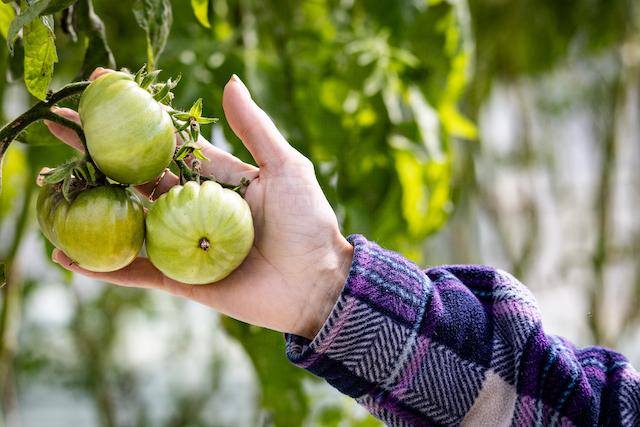The Kola Peninsula is not the kind of place you end up in by accident. This northwestern corner of Russia, a land of frozen tundra and bitter cold arctic winds, lies at one of the very ends of the earth, stretching into the Arctic Ocean and straight toward the North Pole.
But it was no accident that Darra Goldstein, a Russian cookbook author and food scholar, found herself 200 miles north of the Arctic Circle in February—in the dead of the merciless Russian winter. She was there, as she puts it in her recently released book, “deliberately chasing the past.”
Goldstein has been studying Russian culture and cuisine for nearly 50 years, traveling to Russia more times than she can keep track of. But in her new cookbook “Beyond the North Wind: Russia in Recipes and Lore,” she captures what was for her an entirely new way of understanding the country: through its ancient, traditional cuisine, the flavors and dishes tied to the land and unchanged over centuries of tumultuous history.

Author Darra Goldstein. Barry Goldstein
Digging Deeper
Our perceptions of Russian food often jump between two extremes, Goldstein explains: extravagant, 19th-century imperial dining, heavily inspired by French haute cuisine, and austere, kitschy Soviet fare, born under the ever-present shadow of scarcity and hunger. Her first cookbook, “A Taste of Russia,” published 35 years ago, reflected these disparate snapshots.This time, she went in search of the cuisine’s deeper roots, in the remote villages of the Russian North. Here was a region “that hasn’t really been touched by outside influences,” she said. “[I wanted to] see what I could find there, if I could really get to sort of the heart of what Russian taste is all about.”
Here’s what she found, and wants the rest of the world to know.

The icy Arctic waters hold a bounty of fresh seafood for the fishing. Stefan Wettainen
All Things Pickled, Cultured, Cured
It’s not all boiled potatoes and cabbage. Russian food gets an unfair rap for being “bland and stodgy,” Goldstein said, a misconception she traces largely to the impoverished Soviet years. But the cuisine’s true foundational flavors are just the opposite.There’s fiery horseradish and pungent mustard; richly sweet honey and aromatic sea-harvested salts; potent smoked fish and their delicately briny roe. Most essentially, “there’s an incredible taste for the sour,” Goldstein said, evident in the thousand-year-old Russian propensity for “fermenting and culturing just about everything at hand.”
That means dark sourdough rye bread and earthy fermented porridge; cultured milk and butter and a tangy farmer’s cheese called tvorog; and a dazzling array of brined pickles and preserves, from crisp cucumbers to sweet-tart lingonberries. To drink, there’s vodka, of course, a natural complement to these other funky ferments, and also kvass, an effervescent, lightly fermented beverage most commonly made from stale black bread.
These practices are rooted in survival: Stocking up on all things pickled, cultured, and cured was a must for surviving the long, harsh winters of the north.

Sour, piquant, ever-so-slightly-sweet brined tomatoes. Stefan Wettainen
Healthy, Wholesome Staples
Move past the mayo-doused dishes of Soviet cooking, and you’ll find that the traditional Russian diet is actually incredibly healthy—not least thanks to the ubiquity of those fermented foods, packed with gut-friendly probiotics.“Obviously the Russian peasants weren’t saying, ‘I need my probiotics today!’” Goldstein said with a laugh. “But they sort of understood that these are the foods that make them feel good.”
Other staples include comforting, fiber-rich whole grains, such as rye, barley, and buckwheat; plenty of fresh, seasonal produce; and an abundance of freshly caught fish and other seafood, full of omega-3s (a secret to staying healthy in the frigid north, according to Goldstein).

Syrniki, pancakes made with tvorog, a Russian farmers cheese. Stefan Wettainen
Deep Ties to the Land
As Goldstein puts it, “Russians are mad about foraging.” Russian forests and meadows teem with a bounty of wild mushrooms and greens and “beautiful, beautiful berries,” from familiar cranberries and red and black currants to exotic bird cherries and sea buckthorn.They spin their collected treasures into all manner of delights: Spring’s first birch buds are used to infuse vodka; mushrooms are fried in butter or melted into stews; berries are juiced or sugared or baked into pies. Combined with other treasures reaped from the garden or farm, there’s an incredible bounty to be gained from the land, in spite of the harsh climate.

Deep golden sea buckthorn, a wild Siberian berry. Petr Tkachev/Shutterstock
For Russians, Goldstein argues, eating from the land goes much deeper than just sustenance: “There’s a real spiritual aspect to it. It’s something more profound than I think most of us experience,” she said.
She ties it to a core aspect of Russian identity, which she describes in the book as “based for a thousand years on being close to the soil, whether one’s ancestors were landowners or serfs.” And perhaps “in a country where social upheaval and hunger remain within active memory,” she continues, reconnecting with that ancient soil, with the steady rhythms of nature and the seasons, provides comfort, security, and stability.

Russians' connection to the natural world runs deep. PaulPaladin/Shutterstock
Slow Cooking, Slow Food
Time is a crucial ingredient in Russian cuisine; after all, most fermenting, culturing, and curing takes days, weeks, or months to complete. It’s also central to what Goldstein identifies as the very basis of Russian cooking: foods made in a traditional Russian masonry stove.In peasant cottages, these enormous wood-fired stoves were the heart of the home, a source of warmth and nourishment. One often occupied a quarter to a third of the entire living space.

A woman tends to a traditional Russian masonry stove, the heart of Russian cooking. Stefan Wettainen
Many of Russia’s most classic dishes were born from its depths: a multitude of breads, pies, and pancakes, baked while the stove was at its hottest point; and soups, stews, and vegetables sealed in earthenware pots, left to slow-simmer to perfection as the temperature slowly fell. Cultured dairy and dried mushrooms or berries used up the last of its residual heat.
Today, these stoves have mostly survived only in Russia’s rural villages; there’s hardly room for one in the modern urban apartment. But this kind of slow cooking, Goldstein notes, has persisted as the heart of the Russian culinary repertoire.
A Modern-Day Revival
During her visits after the collapse of the Soviet Union, and especially after sanctions on importing food imposed after Russia’s annexation of Crimea in 2014, Goldstein began to notice a revival of interest in traditional Russian foodways.Out of partly economic necessity, partly cultural curiosity, “there were young people [with] entrepreneurial spirit who started exploring old recipes that had been lost, they started making artisanal products,” Goldstein said. They sought to return to farming and foraging, time-honored methods of fermentation and preservation, and even, in some cases, using those traditional masonry stoves to cook. “They started really looking inside Russia for what Russia had to offer,” she said.
This revival comes after years of being cut off from traditional practices—even classic Russian cookbooks weren’t allowed to be reprinted during the Soviet period. “People didn’t know about a lot of the very rich traditions of Russian food; it was as though it had been erased,” Goldstein said.
And so, in rediscovering their culinary past, they’re also “rediscovering their culture in a larger way that had been closed off to them—and that part is very exciting.”






